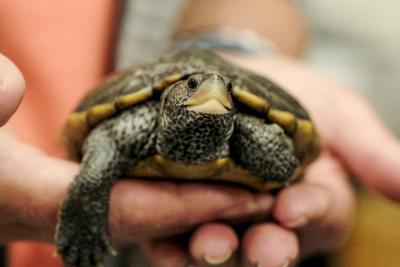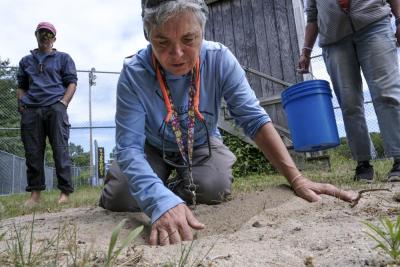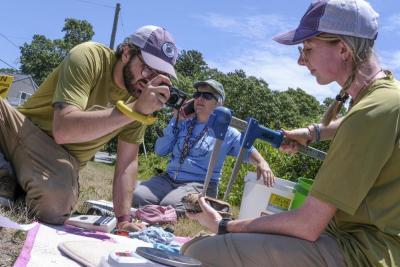Catch, record, conserve: The turtles in our waterways
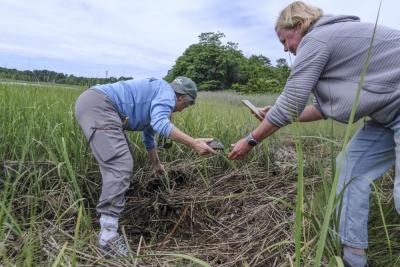
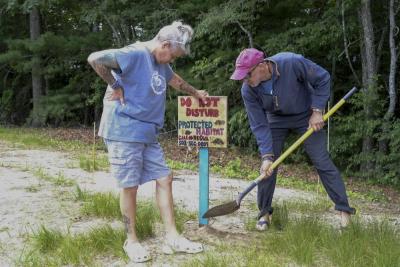
MARION — At a garden in Marion, you won’t find flowers or vegetables growing — but you will find upwards of 600 turtle eggs.
The eggs are spread across about 45 Diamondback Terrapin nests buried beneath a plot of sand at Hammett Cove and are the responsibility of the New England Coastal Wildlife Alliance.
The Diamondback Terrapin, a medium-sized turtle that dwells in the brackish waterways of coastal New England, is a highly threatened species in Massachusetts. In Marion, a 40 by 50-foot sand “garden” for turtles was created 10 years ago for the turtles to safely nest their eggs.
“Why would nature make something so gorgeous? You hold them in your hand, and they look at you with their big eyes, and you fall in love. You fall in love with this little cold-blooded animal,” said Deb Ewing, a Marion resident and steward of the turtle garden since 2015.
The turtle garden, located on public conservation land, is monitored by local stewards like Ewing and the New England Coastal Wildlife Alliance. Ewing said the Cove Housing Association spent over $15,000 to build the turtle nesting area.
The New England Coastal Wildlife Alliance works with communities to protect nests, conduct educational outreach and catch and record about 200 terrapins a year for their extensive conservation work in the marshes of Marion, Mattapoisett, Pocasset and Wareham.
“We need options for these animals,” said Carol “Krill” Carson, the founder and president of the New England Coastal Wildlife Alliance.
Carson said climate change induced factors like rising sea levels and increasing storm severity lead to increased coastal erosion which directly impacts the fragile barrier beaches and shorelines the terrapins nest in.
“With these issues coming down the pike, they're losing their nesting sites. This gives them an alternative,” she said.
Carson, a Middleboro resident and whale biologist, said her team is now in the “turtle season”. The Diamondback Terrapins nest during the summer months, and their eggs hatch in August and September.
Her team of volunteers, many of them high school and college students, race around beaches and marshes across the South Coast. They catch and collect data on the turtle population that is then used by researchers to support conservation and research efforts. They also save turtles and their nests from dangerous situations.
According to the Massachusetts State Fisheries and Wildlife Division, terrapins were nearly hunted to extinction in the early 1900s due to overharvesting for their use in gourmet food. Now, the state lists terrapins as a highly threatened species.
On Friday, June 27, Carson and two volunteers released two “head start” turtles into the marshes behind Wareham High School. These turtles have been raised in an aquarium and given all the food — and attention — they needed as they were cared for by a summer program at Wareham High School. The program, named SAIL, includes after school sessions and a summer program that offers classes in photography, fishing, art and more.
“We're doing something very unnatural. We're keeping them going. We're feeding them and keeping them active,” Carson said.
These turtles have been cared for in a comfortable and controlled environment. Although they still have the brain of a hatchling turtle, their bodies and strength are that of a turtle that is three or four years in age.
Once a pile of reeds and grass were placed on top to cover the turtles on the marsh's edge, that’s the last help they got from Carson and her team.
Between the near constant turtle-sighting calls to Carson’s phone, and approaching almost every resident they see, the New England Coastal Wildlife Alliance strongly relies on the community for its volunteer base and field work.
“We're talking to everybody. Krill talks to everybody. Anybody and everybody that sees [us] out in the field, they're like, ‘you’re the turtle people. I know you. You are the turtle person!’” said Billie-Joe Gibbons, the intern and volunteer coordinator.
For more information on their conservation efforts and how to get involved, visit the New England Coastal Wildlife Alliance’s website.



.jpg)
